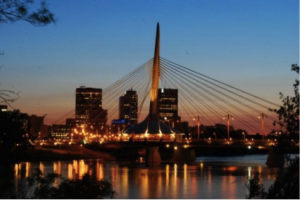Manitoba Population
According to a 2011 estimate, the population of British Columbia is 1,208,268.
Currently, Manitoba’s population makes up approximately 3.6% of the Canadian national population. With a 5.2% population growth, Manitoba is the fifth most populated Canadian province, after Ontario (1), Quebec (2), British Columbia (3), and Alberta (4).
Manitoba Land Area
The land area is 553,556 km^2, or 213,729 mi^2, making British Columbia the eighth largest province by land mass. Manitoba has a saltwater coastline that borders the Hudson Bay and contains over 110,000 lakes, including Lake Manitoba and Lake Winnipeg, the 10th largest freshwater lake in the world. Some traditional native lands and forests on the east side of Lake Winnipeg are a proposed UNESCO World Heritage Site.
Manitoba makes up approximately 6.5% of Canada’s entire area and has a water area of 94,241 km^2, or 36,387 mi^2. It is the 8th biggest province in Canada, after Nunavut, Quebec, Northwest Territories, and Ontario, British Columbia, Alberta, and Saskatchewan.
Manitoba Borders
The west side of Manitoba is bordered by Saskatchewan, while the east is bordered by Ontario province. North of Manitoba are the Nunavut and Northwest Territories, while south of Manitoba is bordered by U.S. states North Dakota and Minnesota. Hudson Bay borders the northeast side of Manitoba.
Manitoba is the only province with both prairie and coastline. Lake Winnipeg ise the 10th largest freshwater lake in the world, and the largest in southern Canada. In addition, Hudson Bay is the 2nd largest bay in the world. Manitoba experiences a continental climate, with little precipitation the summer and extremely long Canadian winters.
 Manitoba Capital
Manitoba Capital
The capital of Manitoba is Winnipeg, named the Cree word for “muddy waters.” Winnipeg is located at the fork of the Red and Assiniboine Rivers and on the eastern edge of the Canadian Prairies.
Winnipeg’s population is the largest in Manitoba, with 730,018. Winnipeg is home to several professional sports teams and universities, such as theWinnipeg Jets (hockey) and Goldeyes (baseball), and the University of Manitoba, University of Winnipeg, and University of St. Boniface, the oldest post-secondary educational institution in western Canada. Winnipeg also has many cultural organizations, such as the Manitoba Theater, Manitoba Opera, Royal Winnipeg Ballet, and Winnipeg Art Gallery, to name a few. Winnipeg’s most popular festivals include the Winnipeg Jazz, Festival du Voyageur, and Folklorama.
Manitoba Federal Representation
Manitoba holds 14 of the 308 House of Commons seats, thus making up 4.5% of the total percentage.
Manitoba holds 6 of the 105 Senate Seats making up 5.7% of the total.
Manitoba Demographics
Ethnic Origins (as of 2006 Canadian Census)
- English – 22.9%
- German – 19.1%
- Scottish – 18.5%
- Ukranian – 14.7%
- Irish – 13.4%
- North American Indian –10.6%
- Polish – 7.3%
- Métis (aboriginals) – 6.4%
- French – 5.6%
- Dutch – 4.9%
- Russian – 4.0%
Winnipeg specifically, known for its cultural diversity, has the highest percentage of Filipinos of any municipality in Canada. The Filipino language Tagalog is 2nd after English in Winnipeg. However, most Winnipeggers are of European descent, and/or classify themselves as Canadian.
One in ten people in Winnipeg speak both English and French.
Manitoba Economic Statistics
Manitoba has a moderately strong economy based largely on natural resources. The GDP of Manitoba was $50.834 billion in 2008. As of October 2009, Manitoba’s unemployment rate was 5.8 percent.
Manitoba’s economy relies heavily on agriculture, tourism, energy, oil, mining, and forestry. Due to the terrain, agriculture is found mostly in the southern half of the province, but some grain farming is in the northern part of the province. 12% of Canadian farmland is in Manitoba.
The most common type of farm found in rural areas is cattle farming (34.6%), followed by assorted grains (19.0%) and oilseed (7.9%). Manitoba is the Canada’s largest producer of sunflower seed and dry beans, and one of the leading sources of potatoes. Manitoba’s potatos are the source of McDonald’s and Wendy’s French fries.
However, Manitoba’s largest employers are government and government-funded institutions, including hospitals and universities.
The Churchill port is the only arctic deep-water port in Canada and the shortest shipping route between North America and Asia. Churchill is the “polar bear capital” of the world. It is famous for beluga and polar bear watches.
Manitoba Historical Population Statistics
| Year | Population |
| 1871 | 25,228 |
| 1881 | 62,260 |
| 1891 | 152,506 |
| 1901 | 255,211 |
| 1911 | 461,394 |
| 1921 | 610,118 |
| 1931 | 700,139 |
| 1941 | 729,744 |
| 1951 | 776,541 |
| 1961 | 921,686 |
| 1971 | 988,245 |
| 1981 | 1,026,241 |
| 1991 | 1,091,942 |
| 1996 | 1,113,898 |
| 2001 | 1,119,583 |
| 2006 | 1,148,401 |
| 2011 | 1,208,268 |
Interactive Canadian Province Population Map
Other Resources
To learn more about the population of Manitoba, click here
Learn more about New Brunswick Population


